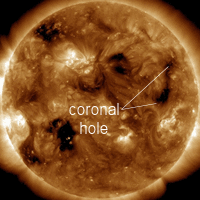SOLAR CYCLE UPDATE: Something unexpected is happening on the sun. 2013 is supposed to be the year of Solar Max, but solar activity is lower than expected. At least one leading forecaster expects the sun to rebound with a double-peaked maximum later this year. [video] [full story]
SDO ECLIPSE SEASON BEGINS: Twice every year, around the time of the equinoxes, Earth can pass directly between the Sun and NASA's Solar Dynamics Observatory (SDO), producing a series of beautiful eclipses from the point of view of the spacecraft. SDO's vernal eclipse season began this weekend, producing a partial blackout of the sun:
During the eclipse, which was centered around 0715 UT on March 3rd, Earth covered about half of the sun. Because these eclipses typically last for only minutes each day (maximum=72 minutes), there is still plenty of uninterrupted time for SDO to monitor activity on the sun. The ongoing eclipse season will end in approximately three weeks. Between now and then, stay tuned for some rare blackouts. Aurora alerts: text, voice.
GEOMAGNETIC DISTURBANCES: A high-speed solar wind stream is buffeting Earth's magnetic field, sparking bright auroras around the Arctic Circle. The sight of the bright green lights overhead is causing some onlookers to do unusual things in the snow:
"I can honestly say I've never seen anyone do The Pyramid under the Northern Lights before," says veteran aurora photographer Ronn Murray of Fairbanks, Alaska. "[On March 1st], I headed up to the top of Murphy Dome with this incredibly fun tour group. We had a blast making portraits under the aurora. The clouds would eventually take over, but we made the most of the show while it lasted."
More auroras are in the offing. NOAA forecasters estimate a 30% to 45% chance of polar geomagnetic storms on March 2-3 as the solar wind continues to blow. Aurora alerts: text, voice.
COMET PAN-STARRS UPDATE: Comet Pan-STARRS, now visible in the southern hemispherre, is brightening as it plunges toward the sun, Amateur astronomer Ian Cooper sends this report from Glen Oroua, New Zealand: "Despite lingering evening twilight and the glare from a nearly full Moon, Comet Pan-STARRS is a 3rd-magnitude object with a fine orange dust tail visible in both binoculars and small telescopes." A 30-second exposure with his Canon 450D digital camera easily revealed the comet in the not-quite-dark sky:
In early March, the comet will pass about 100 million miles from Earth as it briefly dips inside the orbit of Mercury. At that time it is expected to brighten another three-fold to 2nd magnitude, about as bright as the stars in the Big Dipper. Whether Pan-STARRS will actually be visible to the naked eye through the glow of the nearby sun remains to be seen; this NASA video explores the possibilities. Whatever happens, observers in the northern hemisphere will have a front row seat as the comet crosses the celestial equator on March 12th. Stay tuned!
More about Comet Pan-STARRS: 3D orbit, ephemeris, light curves.

![]()
Solar wind
speed: 514.7 km/sec
density: 2.0 protons/cm3
explanation | more data
Updated: Today at 2245 UT
![]()
X-ray Solar Flares
6-hr max: C1 1847 UT Mar02
24-hr: C1 1511 UT Mar02
explanation | more data
Updated: Today at: 2200 UT
![]()
![]()
![]()
Daily Sun: 02 Mar 13
![]()
![]()
Sunspot AR1682 has a 'beta-gamma' magnetic field that harbors energy for M-class flares. Credit: SDO/HMI
![]()
![]()
![]()
Sunspot number: 88
What is the sunspot number?
Updated 02 Mar 2013
Spotless Days
Current Stretch: 0 days
2013 total: 0 days (0%)
2012 total: 0 days (0%)
2011 total: 2 days (<1%)
2010 total: 51 days (14%)
2009 total: 260 days (71%)
Since 2004: 821 days
Typical Solar Min: 486 days
Update 02 Mar 2013
The Radio Sun
10.7 cm flux: 113 sfu
explanation | more data
Updated 02 Mar 2013
![]()
![]()
![]()
Current Auroral Oval:
![]()
Switch to: Europe, USA, New Zealand, Antarctica
Credit: NOAA/POES
![]()
![]()
![]()
Planetary K-index
Now: Kp= 3 quiet
24-hr max: Kp= 4 unsettled
explanation | more data
![]()
Interplanetary Mag. Field
Btotal: 4.0 nT
Bz: 0.3 nT north
explanation | more data
Updated: Today at 2247 UT
![]()
![]()
![]()
Coronal Holes: 02 Mar 13
![]()
![]()
Earth is inside a stream of solar wind flowing from the indicated coronal hole. Credit: SDO/AIA.







